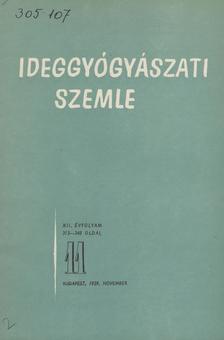The eLitMed.hu medical portal uses computer cookies for convenient operation. Detailed information can be found in the Cookie-policy.
Clinical Neuroscience - 1959;12(11)
Content
[Neurological complications of congenital vitium]
[62 patients with congenital vitium were observed. Of these, 41 underwent regular neurological and 28 EEG examinations. Neurological complications were found in more than 50% (23) of the 41 cases, a higher percentage than the average reported in the literature. It is our hypothesis that to understand the pathomechanism of neurological lesions associated with congenital vitium, patients should be divided into two groups : 1) those in whom cerebral lesions are due to altered haemodynamic conditions and 2) those in whom hypoxaemia is the impairing factor. We analysed the clinical signs produced by hypoxaemia in our patient population and inferred the hypoxaemic tolerance of the brain. In our patients with non-cyanotic congenital vitium (4), we observed signs of reversible functional alteration of the nervous system on load, reversal of the shunt. However, this acute hypoxaemia led to irreversible damage in only one patient with vitium associated with sacer. In our neurologically negative cyanotic patients (6), we attributed the absence of symptoms to compensatory factors (vasodilatation, polyglobulia, etc.) for hypoxaemia. We found that polyglobulia does not parallel the degree of hypoxaemia. It is likely that these two compensating factors interact to varying degrees. Our neurologically negative cyanotic patients provide evidence that chronic hypoxaemia does not imply chronic hypoxydosis. We divided our cyanotic neurologically positive patients into 2 main groups, the complicated compensated adapted and the decompensated adapted. The former group includes 2 patients with cerebral abscesses. These are examples of damage caused by factors that confer adaptation. We have also found symptoms of cerebral anaemia as an acute manifestation of adaptations decompensated to exertion in our cyanotic patients. However, in these patients, unlike in non-cyanotic patients with vitium, we detected a certain percentage of irreversible lesions in the form of abnormal EEG even without loss of consciousness. We found two basic types of adverse effects of chronic hypoxaemia. Both are mainly reflected in EEG lesions. One is the consequence of serial loss of consciousness, the other is the cumulative effect of reversible impairment induced by acute hypoxaemia.]
[Rare neurological lues: acute onset of Nissl-Alzheimer f. capillaris endarteritis meningoencephalitis]
[The clinical presentation and pathological findings of luesian meningoencephalitis in Heveny and its sequelae were described. This case of luesian meningoencephalitis was based on an older and unclear origin of infection caused by Nissl-Alzheimer f. endarteriitis syphilitica. The luesian origin of the endarteritis in question and the primary nature of the vascular wall proliferation are confirmed by our findings and we emphasize that a similar encounter : acute luesian meningoencephalitis in the context of Nissl-Alzheimer f. endarteriitis is not described in previous reports.]
[New data on the clinical and physiological relevance of nocturnal and diurnal epileptic seizures]
[In a study of three hundred epileptic patients, the authors found a strong correlation between the occurrence of seizures during sleep (nocturnal) or during wakefulness (diurnal) and the anatomo-functional organisation of the epileptogenic focus. Sleep provides the most favourable association of preeconvulsive conditions for foci of the mediobasal stock of the temporal lobe, the anterior frontal and temporo-parieto-occipital convexity. Posterior frontal, central, parietal and external temporal cortical foci are primarily under the convulsive influence of wakefulness; focal motor or sensory motor seizures are awakened at night. The time of day at which the seizure occurs and the wakefulness it causes is itself a clinical manifestation of the focus, which also reflects some of the physiological functions of the focus, probably its role in inhibiting or facilitating wakefulness, attention and behavioural processes.]
[The use of concomitant Tetracor-Evipan in the electroencephalographic diagnosis of epileptic seizures]
[1. concurrent tetracor-evipan combined exercise in 93 predominantly unselected patients. Depth of sleep was deepened to Loomis f. stage C-D. 2. Combined loading was significantly more effective than simultaneous loading in the same patients. There were no cases in which the combined exercise was negative when either tetracor or evipan exercise was positive in the same patient, but there were 22 cases in which tetracor exercise was negative in patients in whom the combined exercise was positive. The same was true, although not as predominantly so because of fewer cases, for evipan loading. 3. No generalised seizures occurred during combined exercise. 4. The curve was not disturbed by artefacts or muscle potentials. The patient had the least "unpleasant" experience. 5. Based on the results, combined tetracor-evipan loading seems to be more effective than simultaneous loading and can be used as a routine method.]
[Electrostimulation treatment of rats caused by barbiturate derivatives]
[Based on literature and our experience, we have described the treatment of barbiturate coma. The backbone of modern therapy is the central and peripheral ESt, the methodology and results of which were described and compared with the literature. Theories on the mechanism of action of ESt were outlined. We consider the most probable is the normalization of the reduction of barbiturate block-induced activation of the reticular activating system by extra nociceptive stimuli, and we consider ESt as such a nociceptive stimulus. ]
1.
Clinical Neuroscience
[Headache registry in Szeged: Experiences regarding to migraine patients]2.
Clinical Neuroscience
[The new target population of stroke awareness campaign: Kindergarten students ]3.
Clinical Neuroscience
Is there any difference in mortality rates of atrial fibrillation detected before or after ischemic stroke?4.
Clinical Neuroscience
Factors influencing the level of stigma in Parkinson’s disease in western Turkey5.
Clinical Neuroscience
[The effects of demographic and clinical factors on the severity of poststroke aphasia]1.
2.
Clinical Oncology
[Pancreatic cancer: ESMO Clinical Practice Guideline for diagnosis, treatment and follow-up]3.
Clinical Oncology
[Pharmacovigilance landscape – Lessons from the past and opportunities for future]4.
5.



